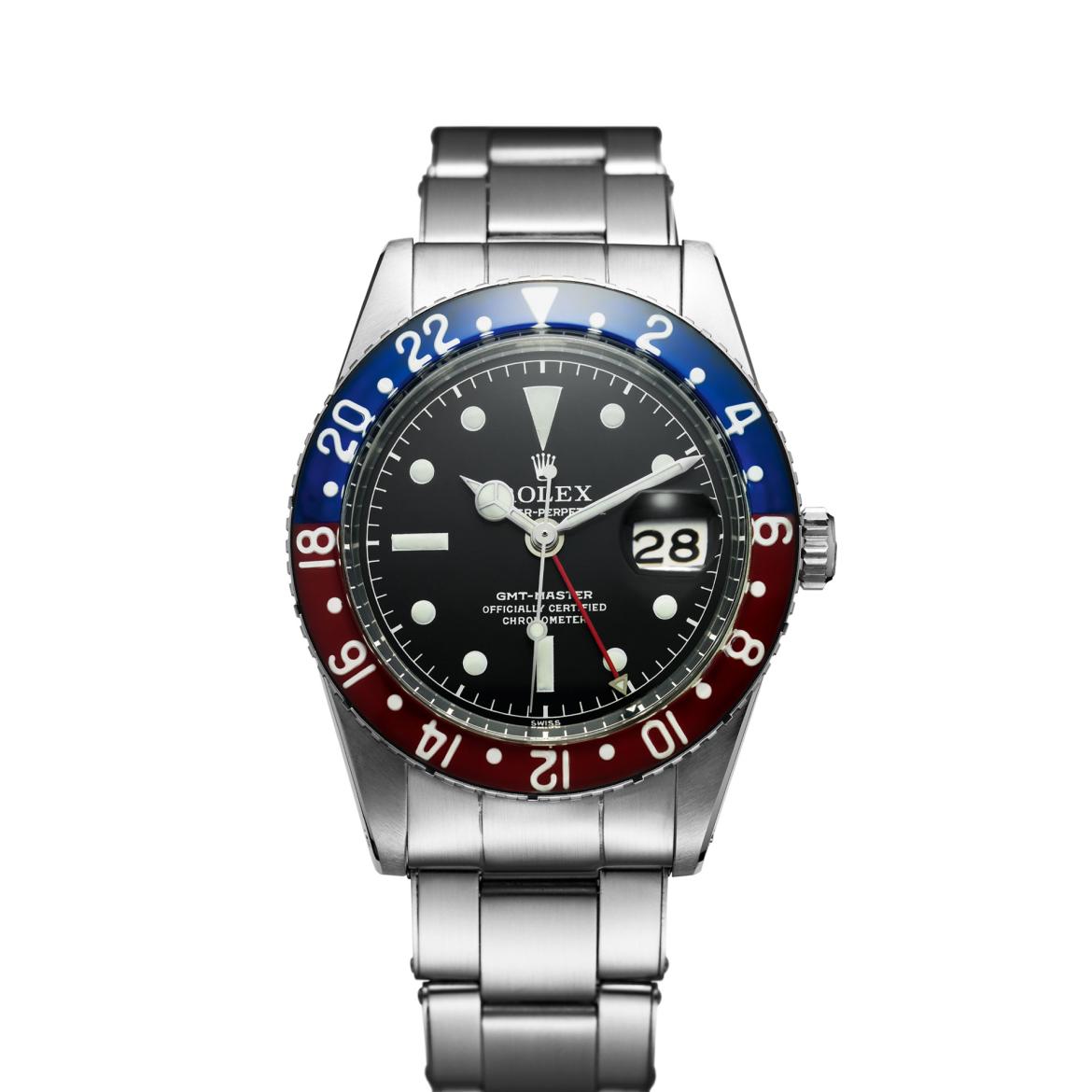Quick specs Rolex GMT-Master ref. 6542
Price 1950s: $ 240 (steel) | $ 600 (gold)
Size: 38 mm
Reference: 6542
Year: 1954 / 1955
Current value (good condition):
Starting at around $ 50,000 | € 48.000 | £ 40,000 | CHF 47’000 (steel)
Starting at around $ 200,000 | € 185.000 | £ 155,000 | CHF 180’000 (gold)
Table of contents first Rolex GMT-Master
- The history of the first GMT-Master starts in 1954
- Name and nicknames of the first GMT-Master
- The Rolex Pan Am connection
- The Ref. 6542 bezel creates some controverse
- Is the GMT-Master ref. 6542 still radioactive?
- Typical design features of the first Rolex GMT-Master
- Dial and hands of the GMT-Master ref. 6542
- Writing on the GMT-Master dial
- Variants of the original Rolex GMT-Master
- Prototype dials of the 6542
- The First gold GMT-Master ref. 6542
- The Albino Rolex GMT-Master ref. 6542, with a white dial
- The Albino GMT-Master is real
- The movement of the Rolex GMT-Master ref. 6542
- Prices of the first Rolex GMT-Master
- Today’s market price of the Rolex GMT-Master ref. 6542
- Current prices for a gold or Albino Rolex GMT-Master ref. 6542
- Is the Rolex GMT-Master ref. 6542 a good investment?
- Technical data and specifications of the first Rolex GMT-Master ref. 6542
The history of the first GMT-Master starts in 1954
The first Rolex GMT-Master is the ref. 6542 from 1954, although Rolex speaks about 1955. Probably as the name GMT-Master was registered by Rolex on the 21st of April 1955. The brand produces this pilot and traveler tool watch until 1959 when it gets a follow-up with the GMT-Master ref. 1676. It is one of the most renewed Rolex watches, and also one of the most copied models when it comes to the design.
The main features are the second hour hand and the graduated, rotatable bi-color bezel. Both to know the time in two time zones at a glance, including if it is day or night in the second time zone. Where the top color, blue with this first GMT-Master, indicates nighttime and the bottom color, red here, indicates daytime. Although on later variants and models the bezel could also be just one color.
Name and nicknames of the first GMT-Master
Assumably the name is a creative abbreviation of “mastering Greenwich Mean Time”, the official determination of different time zones around the world that was adopted at the International Meridian Conference, held in Washington in 1884. The Greenwich Mean Time was the international time standard and an indispensable reference point for the aviation industry until 1972.
The most well-known version of this first GMT-Master is the stainless one with a black dial and blue-red bezel. This is nicknamed as a Pepsi bezel due to its color scheme, or just “The Pepsi” when it comes to the watch. Although some also call the first model the “Pussy Galore”. This because actress Honor Blackman was wearing a 6542 in the Bond movie Goldfinger, released in 1964. So, almost 10 years after the watch entered the market – you’re never old enough for a nickname.
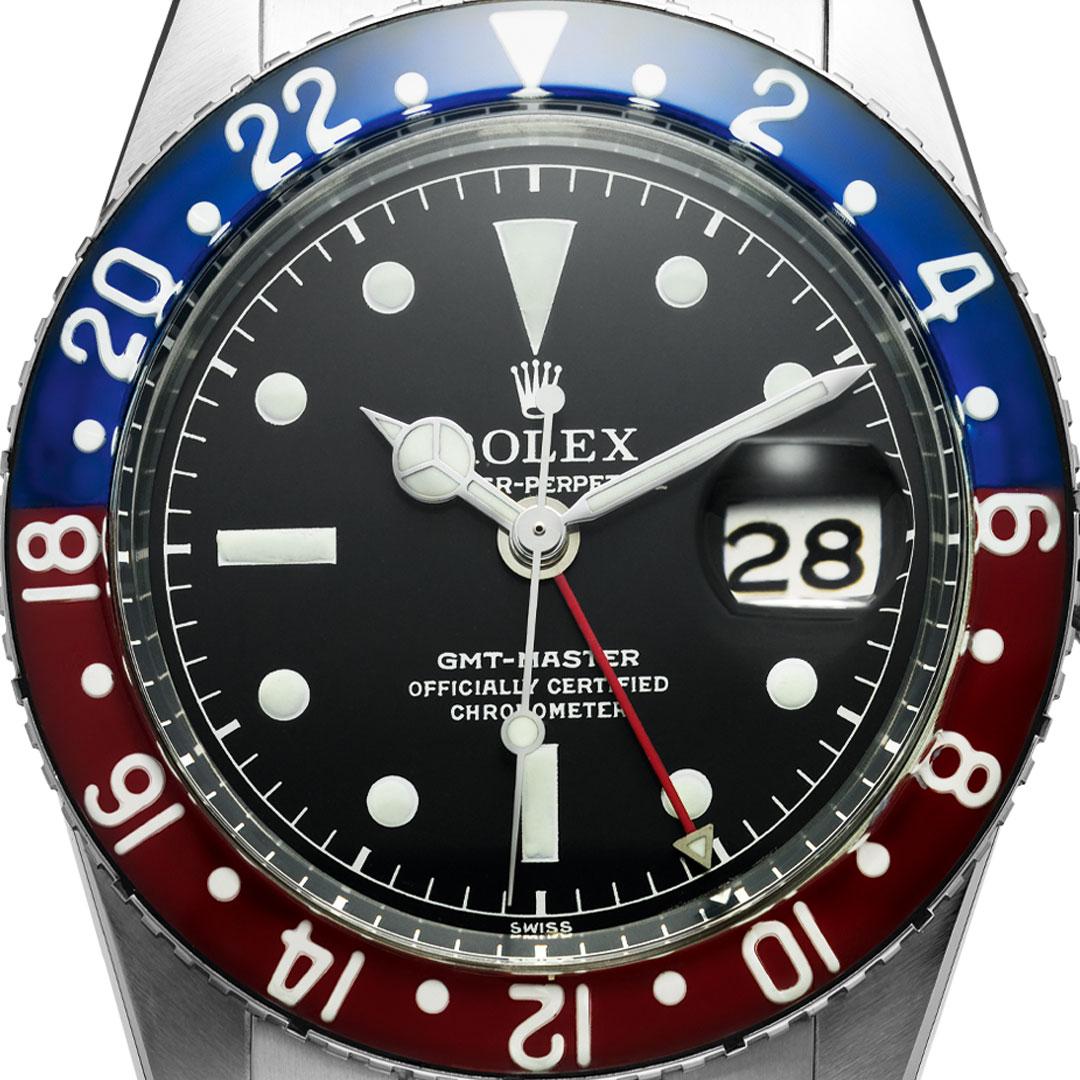
The Rolex Pan Am connection
The case of the Rolex GMT-Master ref. 6542 measures 38 millimeters, and the dial is covered by Plexiglass. Which is an acrylic glass. It has an integrated Plexiglass cyclops lens over the date. However, there are also versions without this cyclops, probably replacement parts not coming from Rolex.
Somewhere in the 1950s it is believed that Rolex got a request from Pan American Airways (Pan Am) to develop a watch that could show more time zones. Perfect for an airplane crew travelling from one time zone to another. So, Rolex creates a watch equipped with a self-winding mechanical movement with a regular hour hand and a connected 24-hour hand. So the GMT hand cannot be adjusted individually, like on the modern GMT-Masters.
Both hour hands indicate the same time but on two different time scales. To see the time in another time zone, one turns the bezel in steps of one hour to show another time with the 24-hour hand on the scale of the bezel.
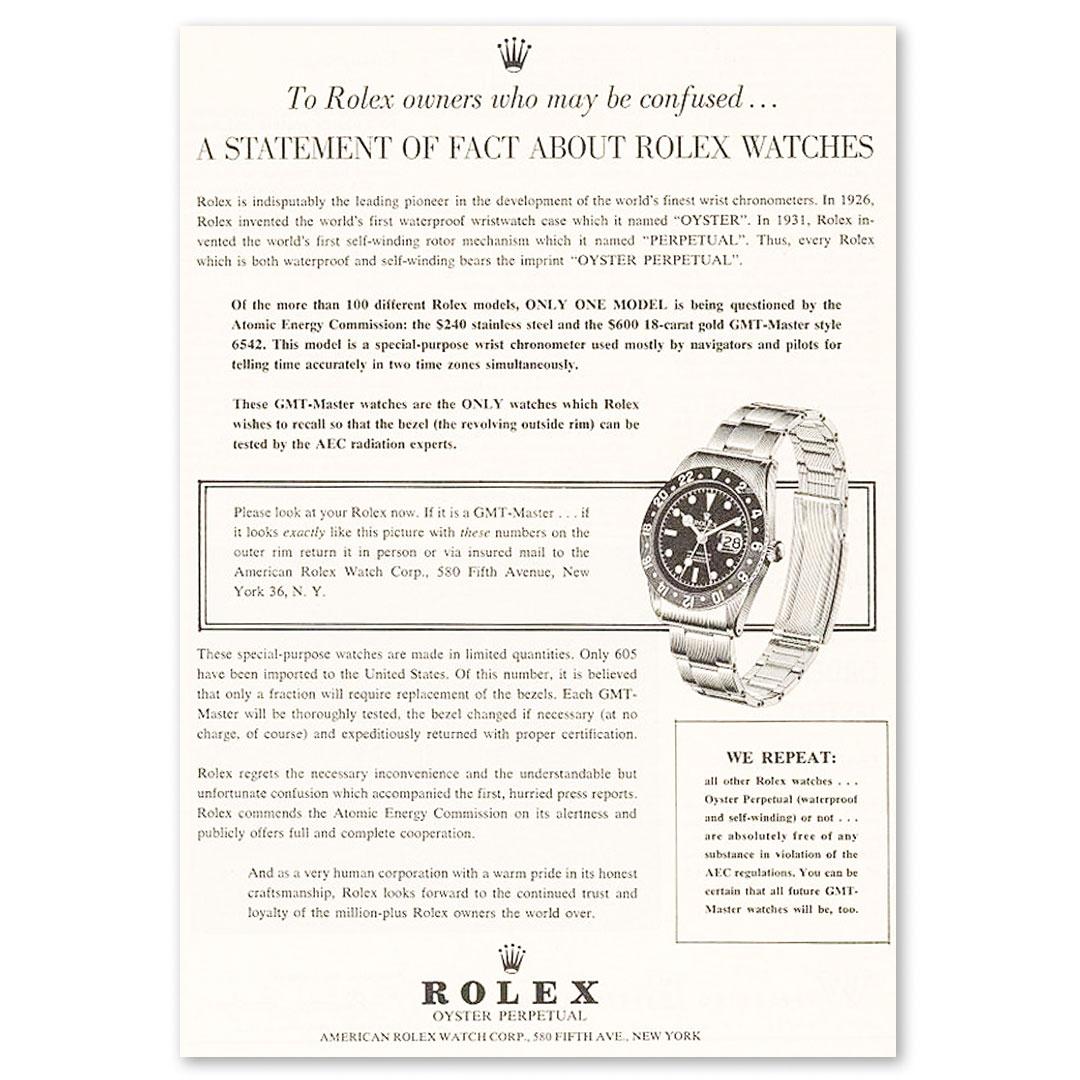
The Ref. 6542 bezel creates some controverse
The notched bezel itself is steel and has a 24-hour graduated insert of Bakelite. This Bakelite is later replaced by anodized non-luminous aluminium toward the end of the 6542’s production. For three reasons. The Bakelite cracks rather easily, it fades a lot over time, and in this model it contains luminous material that happens to be very radioactive. Some sources talk about radium, others about strontium 90 as the luminescent material, or even a mix. On the bezel, and on the dial and hands too. Nevertheless, both are very harmful.
This radioactive material causes trouble, in the US for instance, so Rolex decides to replace the Bakelite where possible after a recall. For that reason, an original Bakelite version is very rare these days. As said, they replace the Bakelite inlay for an anodized metal one, however there are also stories about Rolex service centers who just scraped-out the radioactive material of the bezel inserts. Sometimes replaced with tritium, sometimes left empty. There are also aftermarket Bakelite inlays with tritium. At some point, likely in 1957, any new 6542 gets the aluminium inlay, and at some point, maybe around the same time, the lume on the dial is tritium.
Is the GMT-Master ref. 6542 still radioactive?
Yes, the Rolex GMT-Master ref. 6542 can still be radioactive when the bezel and/or dial have not been replaced. The strontium 90 and radium used on the bezel and dial stay radioactive for a long time. After about 30 years strontium 90 loses half of its “power”, after 60 years still 1/8 part is active. Radium takes about 1,600 years to half in radioactivity. So today, it is still not advisable to work on watches containing those materials yourself.
Back in the days at least one known agent of Rolex, Liebermann Waelchli & Co., issued a certificate stating that a watch was free of Strontium 90. It is not clear if more agents and dealers did this, or even if Rolex itself issued these certificates as well. Rolex issued a “Statement of Fact” in the US about the bezel.

Typical design features of the first Rolex GMT-Master
The case slightly changes during those first years but it stays without crown guards – those are introduced with the next version. The steel twin-lock crown has Rolex’ five-pointed coronet logo with a line under it, the so called “underline crown”. The Plexiglass on top and Pepsi-colored Bakelite or aluminium bezel, are recognizable features, but there is more. Of course, the 24-hour scale on the bezel, including a large triangle marker at the 12 o’clock position that helps indicating other time zones.
Another large triangle is at the 12 o’clock position of the dial. A nod to pilot watches used for orientation purposes, with luminescent material to show the “north” position of your watch in the dark, for instance. If you look clockwise, this luminescent triangle is followed by luminescent hour markers shaped as a dot, except for the 3, 6 and 9 o’clock position. At 3 there is the date, we’ll come back to that later, and at 6 and 9 there is a luminescent baton.
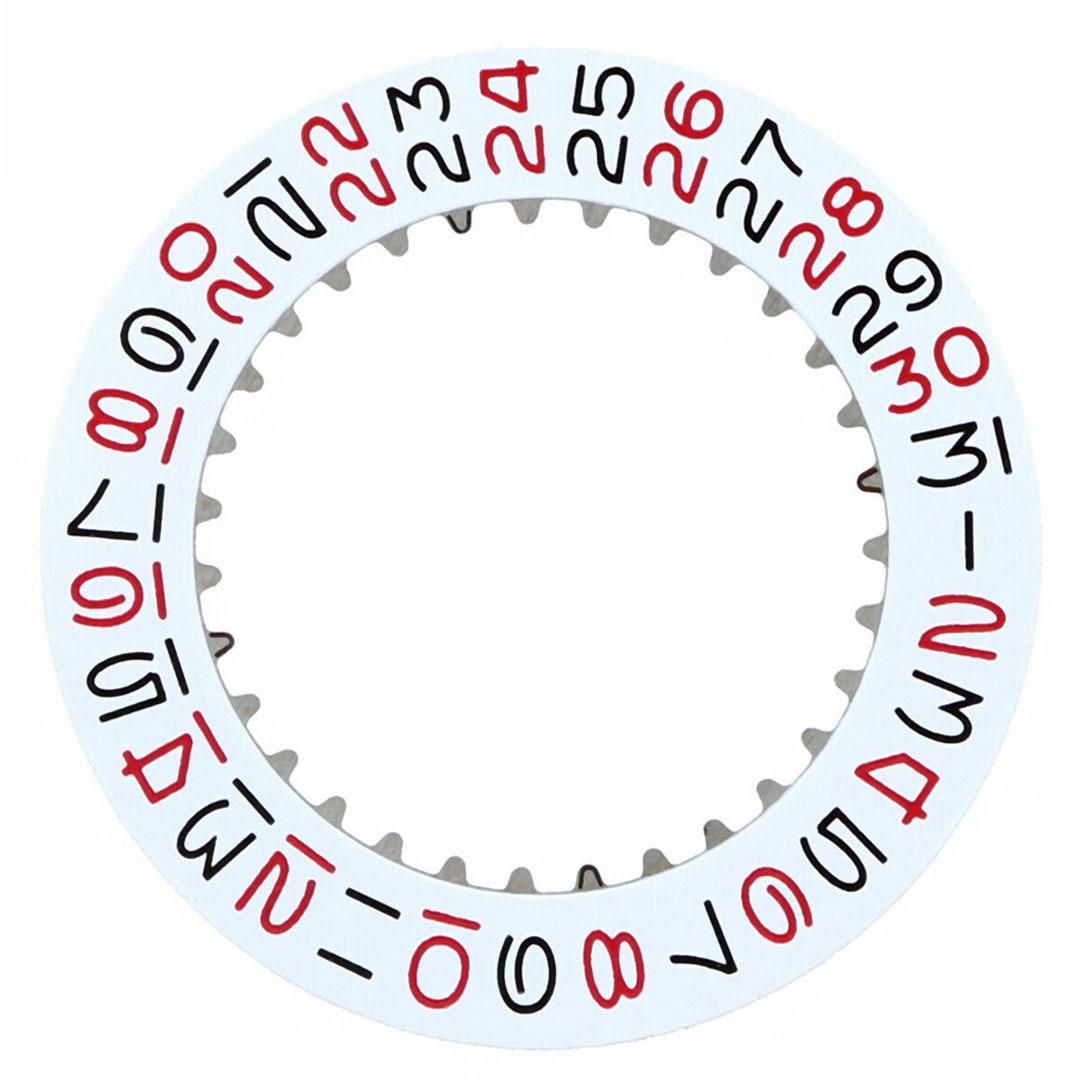
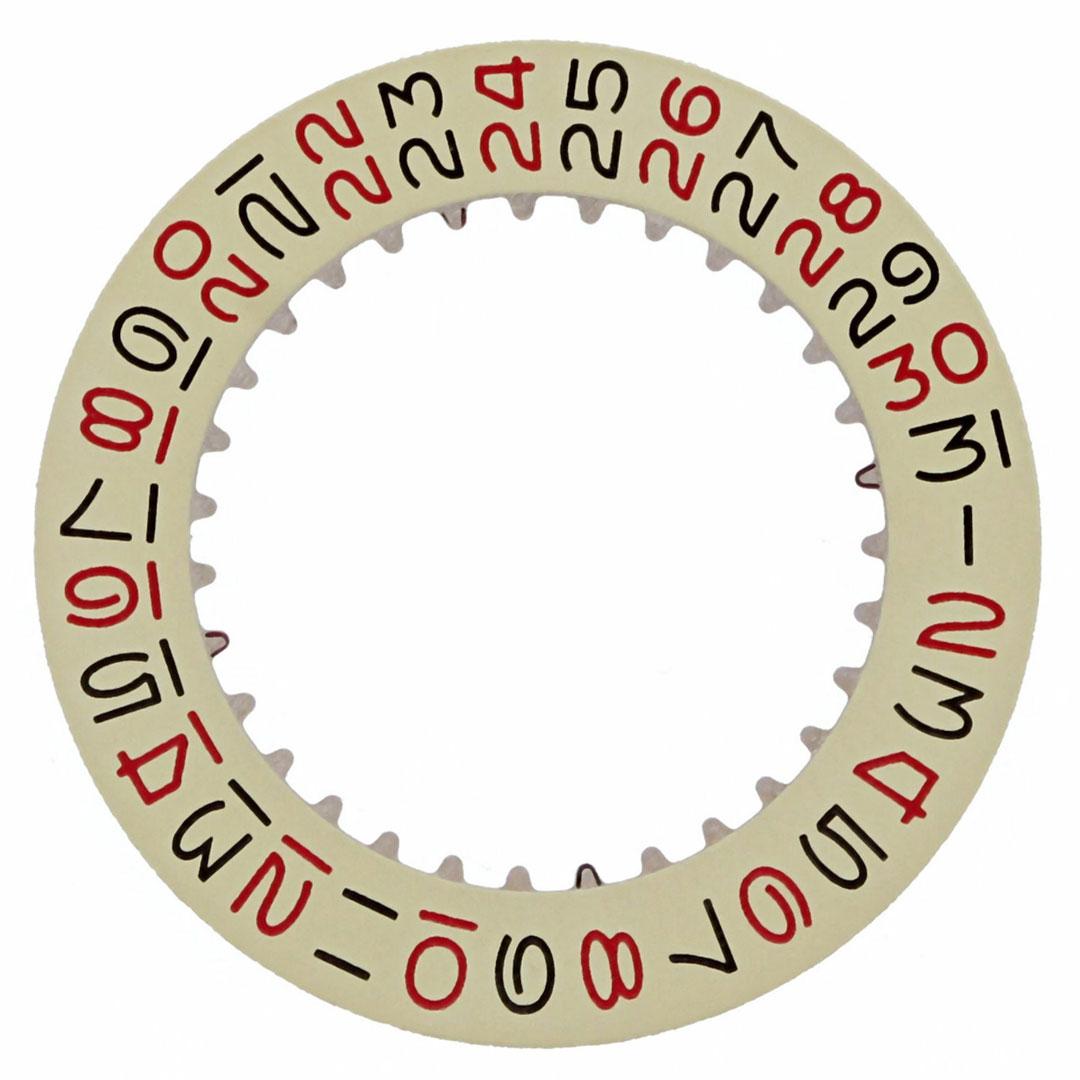
Dial and hands of the GMT-Master ref. 6542
The original Rolex GMT-Master ref. 6542 has a black gilt dial, a bit glossy. Due to the influence of light and especially due to the radioactive luminescent material the dial can become or has already become “tropical”. Which means it’s brown-ish, faded, as the radioactive material provides a vintage-like patina. However, if you continue reading, you’ll find out there is a champagne, brown and white dial too.
The date, on a white background, has black and red numbers (roulette style, even numbers in red) however there are also examples with only black numbers. The chapter ring on the dial looks white-ish.
Every GMT-Master has four hands, all from 18-carat gold. A short so called Mercedes hour hand, as it looks like the logo of the German car brand, with a sharp triangle tip. Each part of this hand, five in total, has luminescent material. The minute hand is straight with a tapered beginning and end, with one big line of luminescent material. Then there is a slender long white seconds hand with a luminescent dot in the middle. It is a so called Lollipop hand, with a smaller dot at the other end as a counterweight. And lastly a slim red GMT hand with luminescent triangle tip.
Writing on the GMT-Master dial
From top to bottom, the gilt writing on the dial starts with the Rolex logo, a five-pointed coronet, followed by the brand’s name in capitals: ROLEX. Under the name is OYSTER-PERPETUAL referring to the oyster-like case construction introduced in 1926 to ensure its waterproofness and referring to the self-winding automatic movement of the brand, introduced in 1931.
Below the central ax of the hands, it reads GMT-MASTER, we all know why, in a slightly larger font, followed by OFFICIALLY CERTIFIED CHRONOMETER. This in the same font size as OYSTER-PERPETUAL, and it refers to the certification of the watch when it comes to precision and accuracy.
Nowadays we known it as the COSC certification of the Federation of the Swiss Watch Industry that was founded in 1973. Back then a brand could print this on its dial when it had an Observatoire Chronométrique Certifié (OCC). Therefor dials with this are also known as OCC dials. Lastly, under the 6 o’clock marker you can read SWISS referring to the country in which the watch is made.
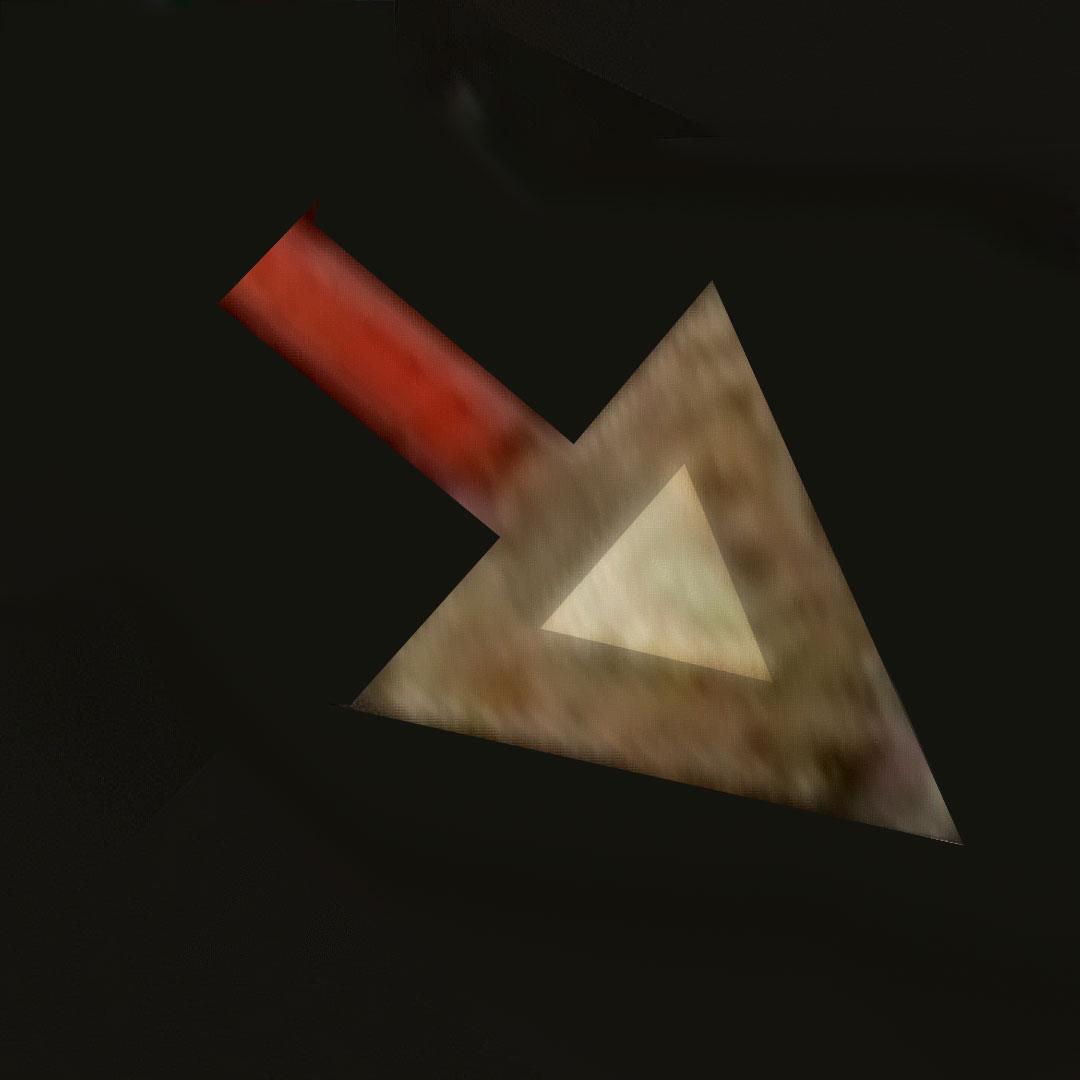

Variants of the original Rolex GMT-Master
The 6542 has a slim 24-hour hand with luminescent material on its triangular tip, which can be found with a thick triangle with a small luminescent area or with thinner outlined triangle with luminescent fill. Its successors from 1959 and onwards would have a more prominent 24-hour hand by the way.
There are also dials with somewhat bigger lume plots, called a “maxi dial”. Those dials also have a larger triangle-shaped 12 o’clock marker that almost touches the Rolex logo. And there are dials with GMT-MASTER printed in red or pink. Possibly prototype dials.
Prototype dials of the 6542
Some versions look to have a black with red bezel, but that’s probably decolored. And some have dials with a company name printed above GMT-MASTER, like Tiffany & Co. And there are versions with the depth rate printed on the dial in red: 50 m – 165 ft or 50 m = 165 ft. Even in combination with a pink GMT-MASTER print. Some say it’s a replaced dial, as Rolex wants to get rid of all the radioactive materials and replaces dials for a “service tritium dial”. Others say it’s part of the first batch of dials for Pan Am, so a kind of (1954) prototype dials.
It raises the question: would Rolex use the new name “GMT-Master” on a dial while the name was not even registered yet? As the latter happened in 1955. So that any competitor could have used the name without consequences? Nowadays that would never happen, and we doubt if Rolex took this risk at the time.
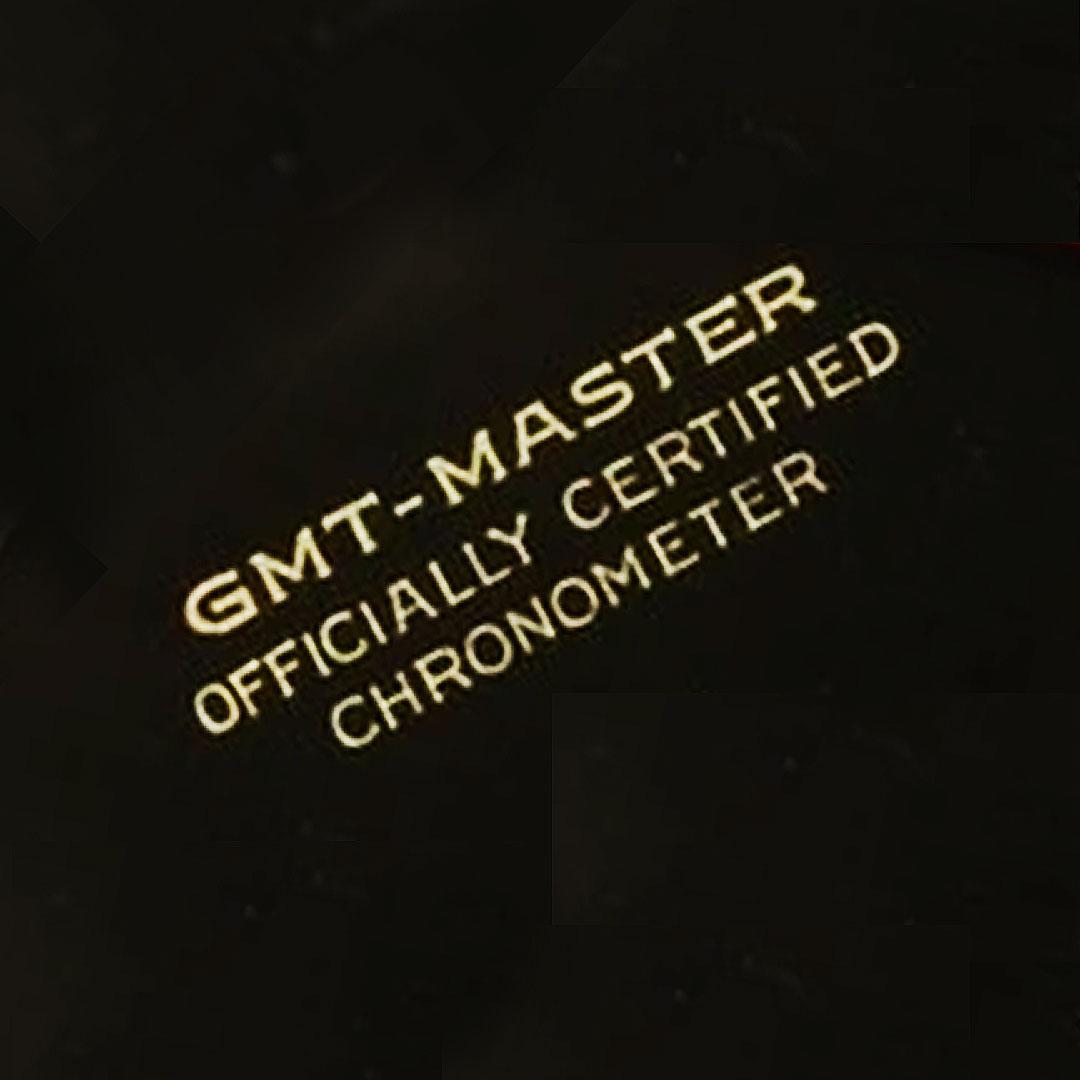
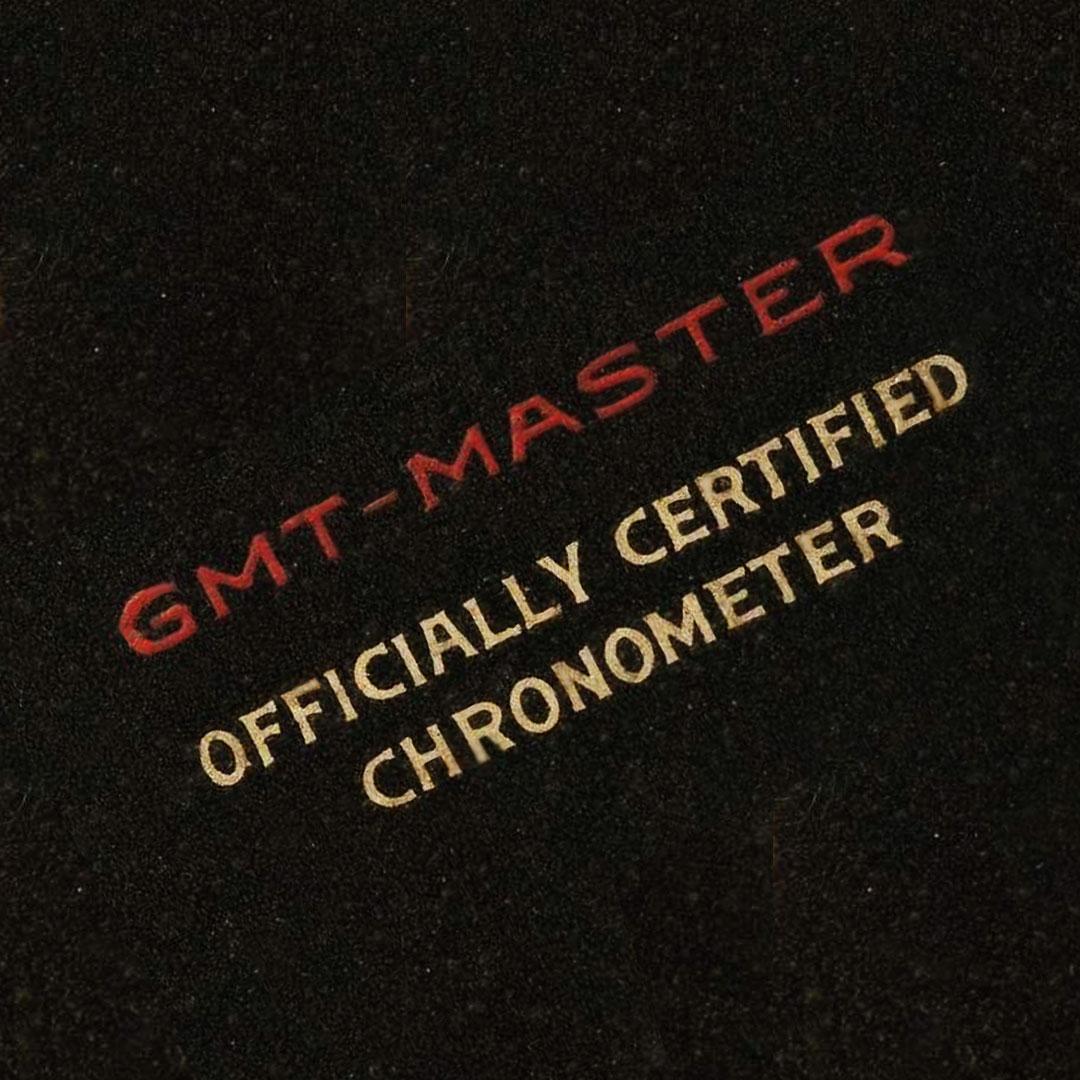
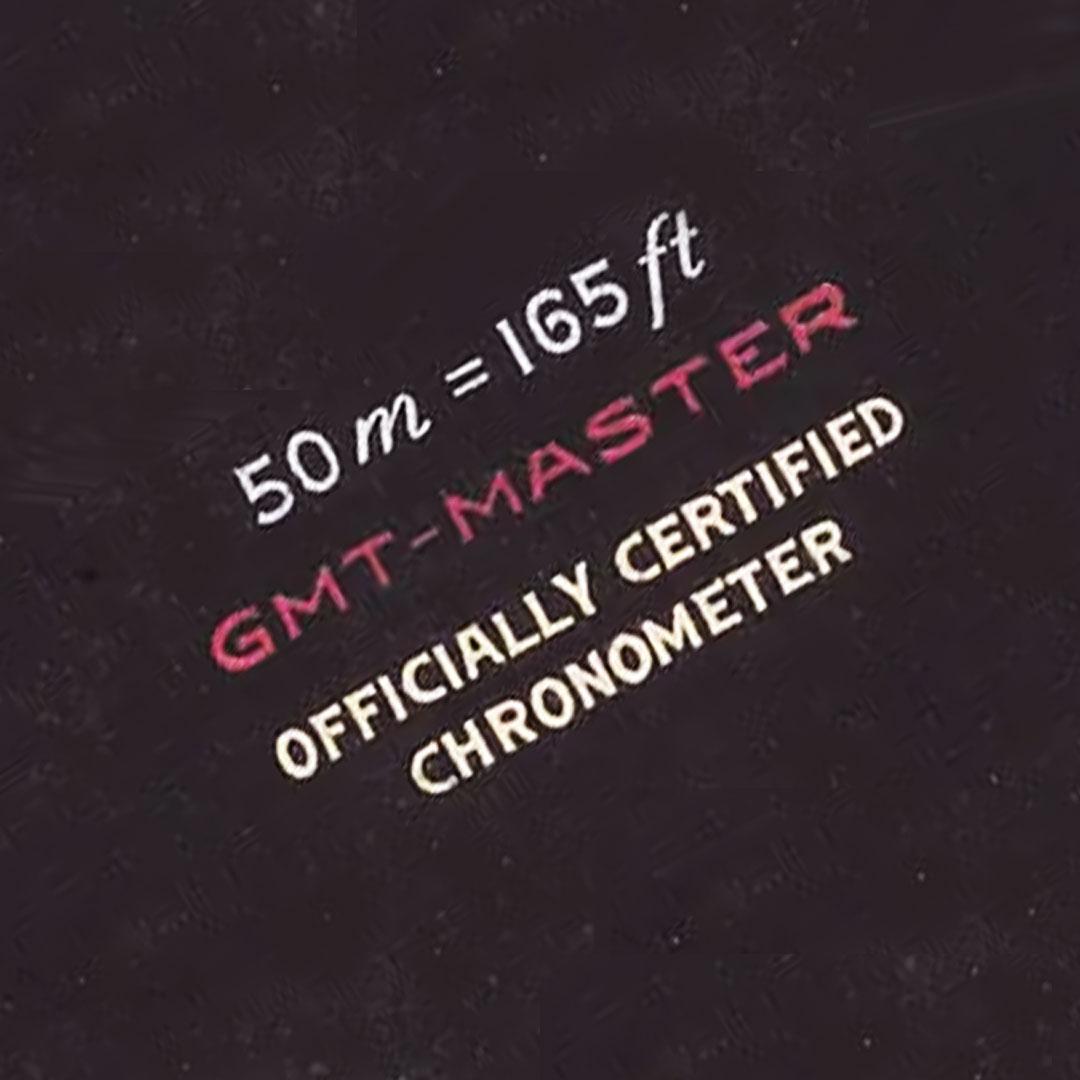
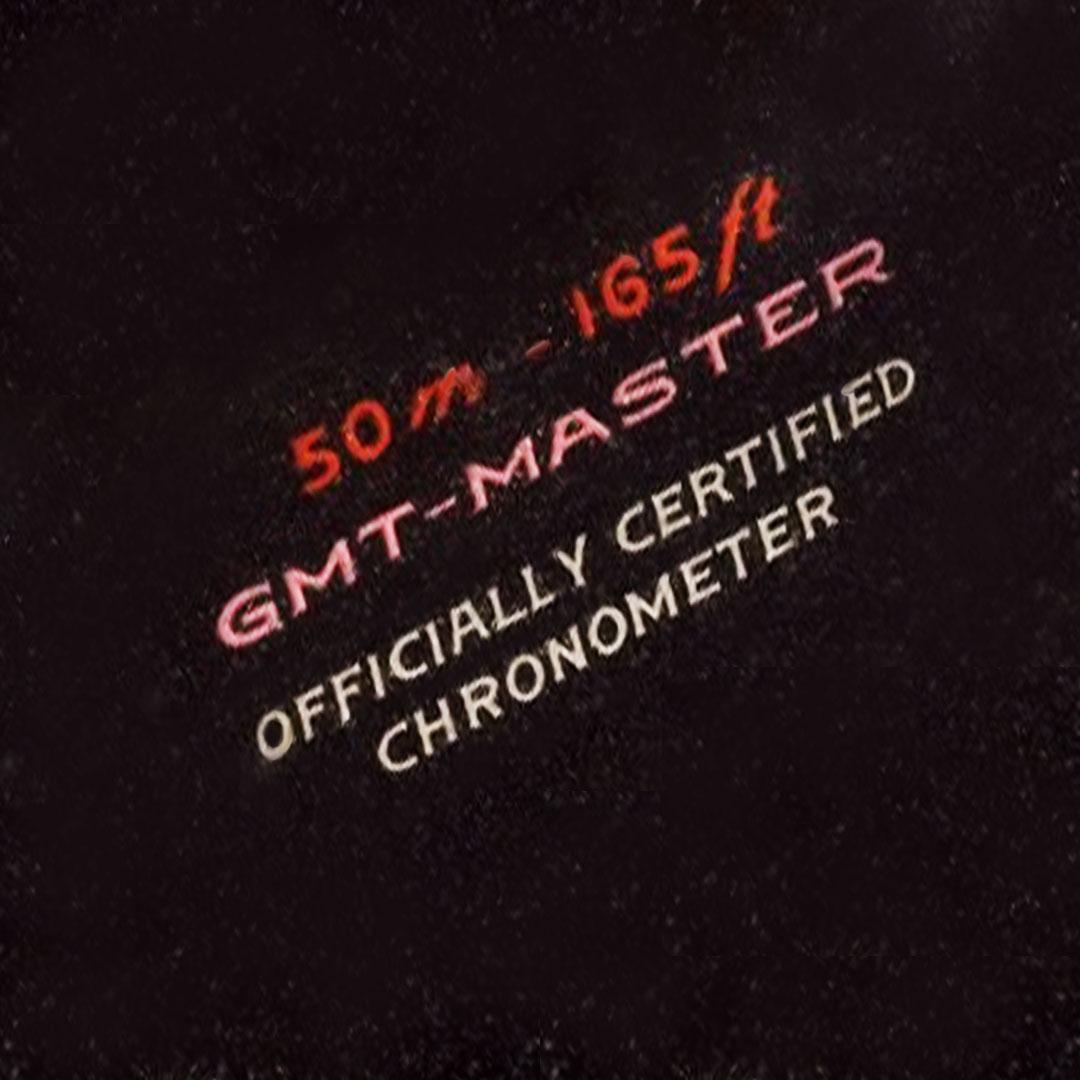
The First gold GMT-Master ref. 6542
It’s not all about steel with the GMT-Master. As there is also a Rolex GMT-Master ref. 6542 in yellow gold. Rolex produces this model between 1958 and 1959 and it has a brown or champagne dial, and a brown bezel without a day/night indication. Furthermore, these gold versions have so called nipple-style hour markers, a kind of curved or 3D-like dots and bars.
It is not sure if the champagne dial is original, or just a tropical brown dial, or an after market or service dial. And it is said that there are gold versions with a white dial, a gold dial and even with a black Bakelite bezel combined with a brown dial. There is no evidence that these are original. Take a look at a gold GMT-Master with white dial sold by Hindman Auctions.
Not only the case material is different, the hands differ too. The first gold GMT-Master has so called alpha hands, a tapered design that narrows in the direction of the edge of the dial. The seconds hand has a so called baton style, straight and simple, with a counterweight. Lastly the GMT hand has the same gold color as the other three hands. The yellow gold GMT-Master runs on the Rolex caliber 1065.
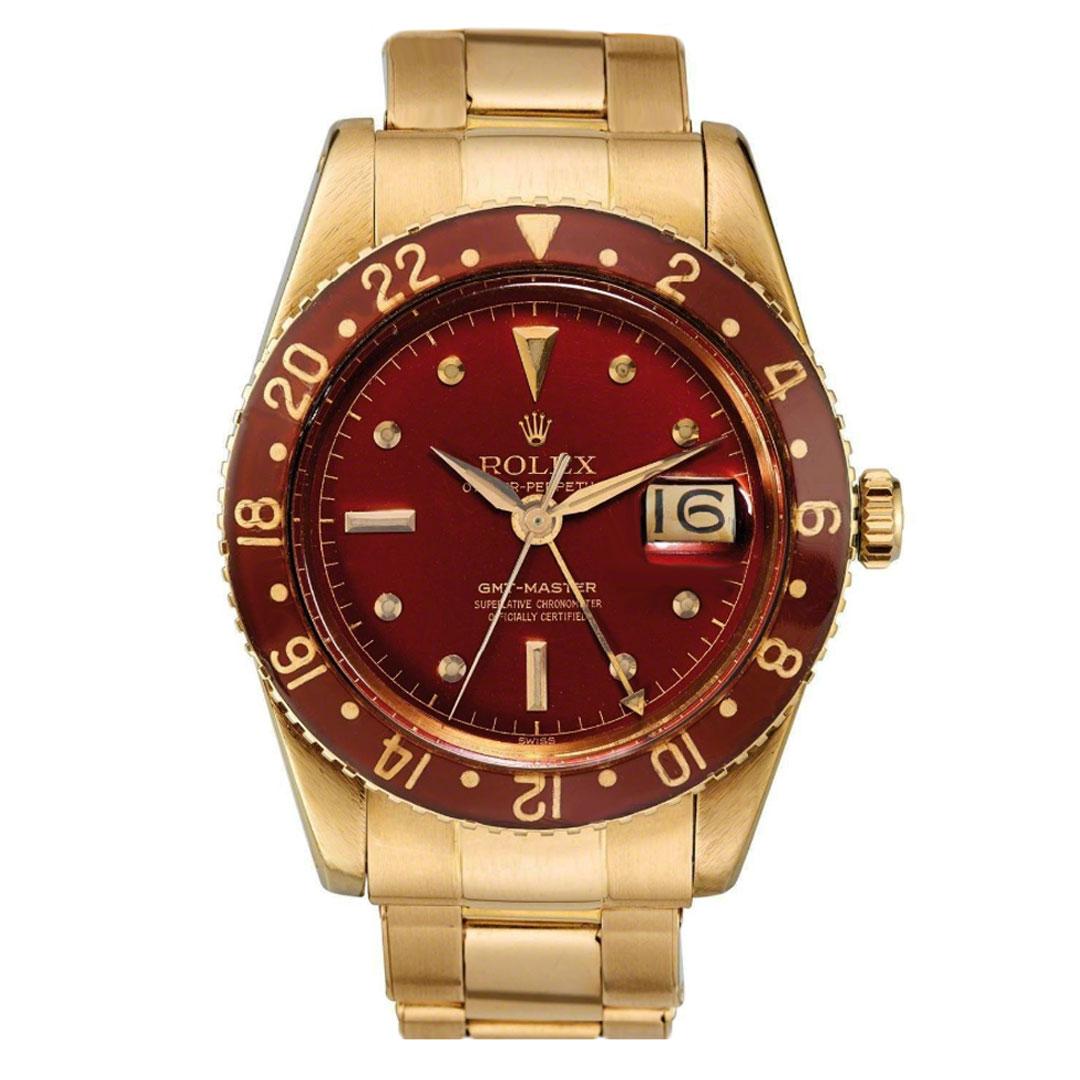
The Albino Rolex GMT-Master ref. 6542, with a white dial
There are even more reference 6542’s then the steel and gold we have just highlighted. As there is a steel version with a white dial too, nicknamed the Albino. Only, Rolex has never declared that they have made a white ref. 6542.
The story goes that executives of Pan Am asked for another GMT-Master than the black version their pilots and crews were wearing. Just to distinguish themselves with a special version of the GMT-Master. Some say maybe 100 pieces were delivered, however the whole of the US got about 605 regular ones in the production period, according to a 1959 statement of Rolex, so this number isn’t very likely.
The Albino GMT-Master is real
The Italian Rolex expert Stefano Mazzariol researched a copy of a white Rolex GMT-Master ref. 6542. This one was produced in 1958, which is engraved on the inside of the case back. Which was done by Rolex until the middle of the 1970s – year and quarter of production, the latter indicated in Roman numerals. In 2010 Mazzariol stated that the one he has researched is a genuine one. No doubts, but for the production year we would say: only if this case back is the original of this watch.
And if so, the story of the executives is only true when these executives were very slow – their staff was already wearing black GMT’s for four years. Or Rolex took a long time to make white dials. Unlikely too. But the Albino GMT-Master is real. Only nobody knows why they were produced, and how many. And when, as the case back is dated, but the dial isn’t.
The movement of the Rolex GMT-Master ref. 6542
The first 6542’s run on the automatic Rolex caliber 1036 GMT, which is a Rolex caliber 1030 (stamped on the bridge of the 1036 GMT) with added GMT function. Rolex uses this movement from 1954 to 1959, however in 1957 it is replaced by the Rolex caliber 1065. In use until 1959 as well, but in 1957 they also use the Rolex caliber 1066 until the end of production.
All these movements have a bi-directional perpetual rotor shaped like a butterfly. And they are finished very nicely, with Côtes de Genève-like polishing and gold engravings. The frequency is 18,000 vph, normal at the time, so that the power reserve could be around 38 hours. It is still pretty well serviceable although some (original) parts are expensive.
The standard bracelet of the Rolex GMT-Master ref. 6542 is a rivet style stainless steel bracelet with a steel folding clasp. There are a few types of this bracelet and clasp and the watch can also be found – original or not – on other Rolex bracelets.
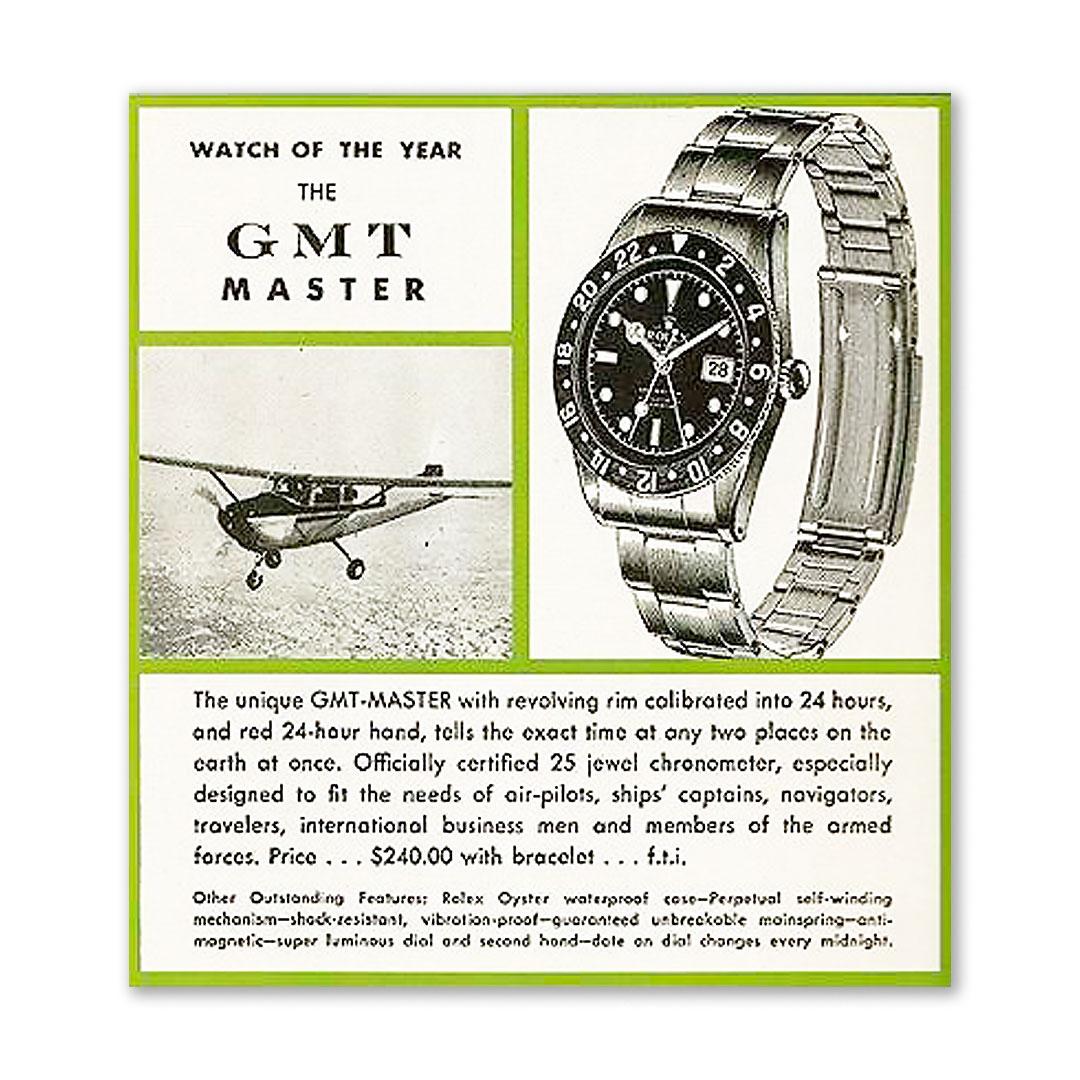
Prices of the first Rolex GMT-Master
The steel Rolex GMT-Master ref. 6542 costs 240 dollars in the late 1950s, which is about 2,400 in today’s money. The gold Rolex GMT-Master ref. 6542 costs 600 dollars, about 6,000 now. The sales started in 1955 we assume, and there are examples that were sold as new in the mid-1960s.
Which is normal: Rolex engraved the quarter and year of production in the case back, but then a watch was for instance exported, displayed at a store or for any other reason not directly sold. And as the warranty starts at the day of purchase, this wasn’t a problem for customers. And still isn’t.
Today’s market price of the Rolex GMT-Master ref. 6542
Today’s prices for the first Rolex GMT-Master ref. 6542 are roughly starting at 20,000 dollars for a fair quality but modified example. So, no original bracelet, a replaced metal bezel that is not the original replaced one, a heavily polished one, etc. A pretty good one, with some issues, can do 50,000 dollars, maybe more. We have seen original Bakelite bezels for 30,000 dollars. Only the bezel…
An almost original ref. 6542, with original Bakelite bezel, including box and papers, is unique and can easily go for 100,000 to 150,000 dollars or more. If the markers on the dial are not too faded, if the movement is fully original, if it has the early Rolex caliber 1036 GMT, etc. Look at this 1956 model sold by Christie’s in 2022. Or this 1955 GMT-Master with special dial that hit 260,000 euros in 2024. We wouldn’t be surprised if the 6542 will break through the 500,000-barrier in a few years.
Current prices for a gold or Albino Rolex GMT-Master ref. 6542
The gold GMT-Master 6542 can be found for 60,000 to 75,000 dollars but then the condition or originality is not that good. For nice, almost original ones, prices start around 150,000 to 200,000 dollars, and collectors are sometimes willing to pay even more.
The 6542 with white dial has never been offered for sale as far as we know. If an example will be offered for sale it will be worth whatever someone is willing to pay for it. A Daytona owned by Paul Newman unexpectedly went for almost 18 million in 2017, and although a white GMT-Master might not have had a famous owner, it could easily hit a million plus.
Is the Rolex GMT-Master ref. 6542 a good investment?
Although we think you should not buy a vintage Rolex (or any other brand) as an investment, it still is a good investment. Prices of models like the GMT-Master never went down shockingly, and especially the 6542 is rare. In original condition or in nearly mint condition. Just always, always have at least two experts take a look at what you want to buy. As there are a lot of parts that can be replaced, with third-party parts or newer Rolex parts, making the watch less original. And if you have come this far in reading this article you have a little idea on how a 6542 should look like.
Despite these high prices the GMT-Master remains a rather simple, unique, and very useful watch to read two times at the same time. The overall story about the watch has all the ingredients to be special: controversial, mysterious, ground-breaking, and very, very popular. Even today’s versions, that can easily be traced back to the first GMT-Master when it comes to design and practicality.
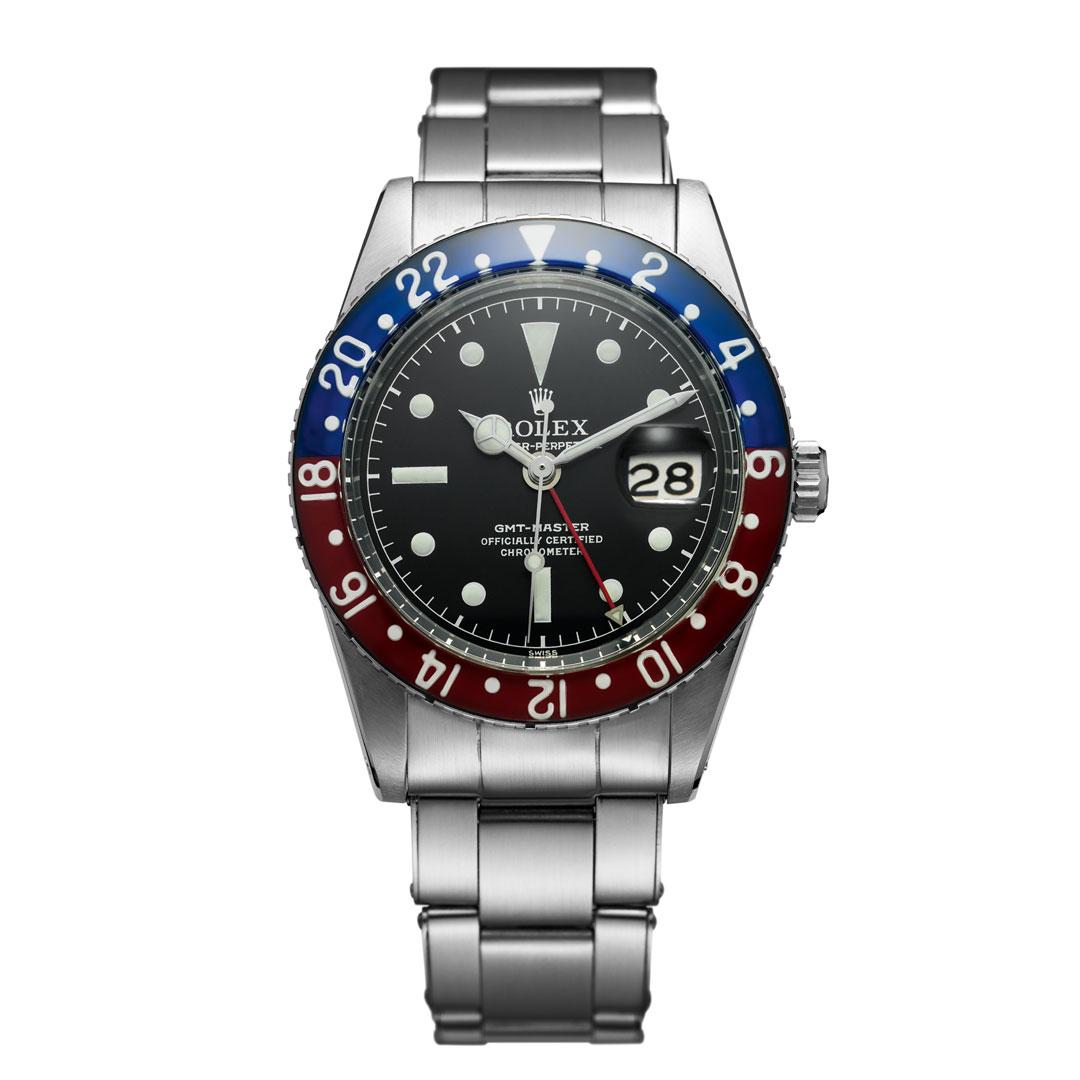
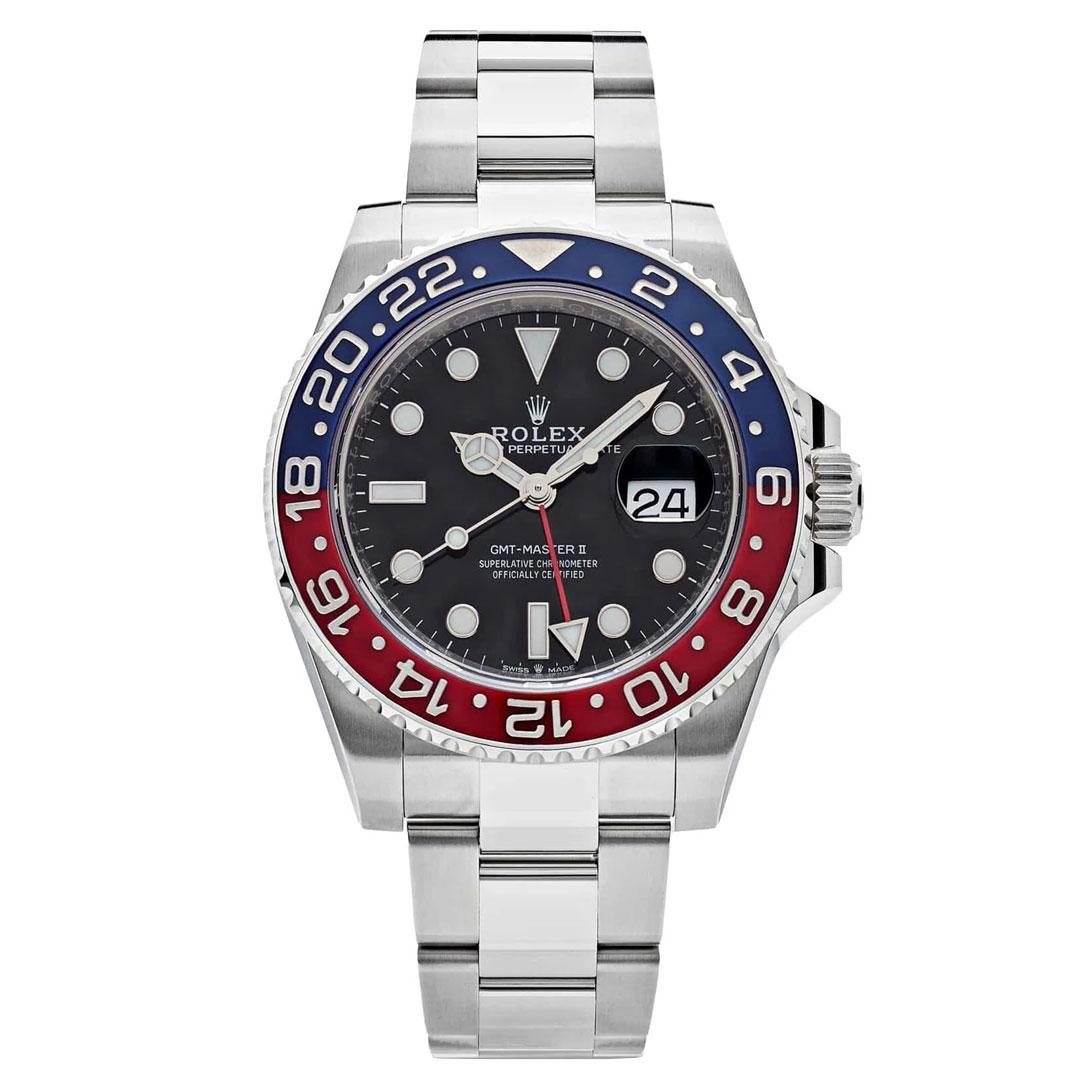
Here you can read about the history of Rolex and the moment that Hans Wilsdorf and Alfred Davies join forces. And maybe you are interested in the first ever Audemars Piguet Royal Oak (the ref. 5402ST series A) as well.
Technical data and specifications of the first Rolex GMT-Master ref. 6542
| Reference number: 6542 |
| Movement: Rolex caliber 1036 GMT | Automatic | Diameter: 28.5 mm | Thickness: 6.44 mm | Frequency: 18,000 vph (2.5 Hz) | Jewels: 25 | OCC certified | Hours, minutes, seconds, date, GMT | Power reserve: approx. 38 hours |
| Case and dial: 38 mm | Stainless steel | Thickness: approx. 13 mm | Plexiglass (acrylic glass), with cyclops lens for the date | Notched stainless steel bezel with Bakelite inlay in blue and red or anodized aluminium inlay in blue and red (later models) | Black gilt dial with white minute track | 18-carat gold hour, minute and second hands with luminescent material | Red 18-carat gold GMT hand with triangle tip with luminescent material | Twin-lock screw-down crown | Solid screw-down case back | Water resistance: 5 ATM / 5 bar / 50 meters / 165 feet |
| Strap: Stainless steel rivet bracelet (ref. 6636) | Stainless steel clasp |
| Price Rolex GMT-Master ref. 6542 (1950s): $ 240 (steel) $ 600 (gold) |
| Website: www.rolex.com |
